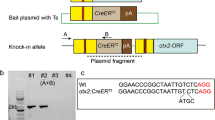Abstract
In order to study the impalpable effect of GFP in homozygous heart-specific GFP-positive zebrafish during the early stage, the researchers analyzed the heart function of morphology and physiology at the first 3 days after fertilization. This zebrafish line was produced by a large-scale Tol2 transposon mediated enhancer trap screen that generated a transgenic zebrafish with a heart-specific expression of green fluorescent protein (GFP)-tagged under control of the nppa enhancer. In situ hybridization experiments showed that the nppa:GFP line faithfully recapitulated both the spatial and temporal expressions of the endogenous nppa. Green fluorescence was intensively and specifically expressed in the myocardial cells located both in the heart chambers and in the atrioventricular canal. The embryonic heart of nppa:GFP line developed normally compared with those in the wild type. There was no difference between the nappa:GFP and wild type lines with respect to heart rate, overall size, ejection volume, and fractional shortening. Thus the excess expression of GFP in this transgenic line seemed to exert no detrimental effects on zebrafish hearts during the early stages.






Similar content being viewed by others
References
Heim R, Prasher DC, Tsien RY (1994) Wavelength mutations and posttranslational autoxidation of green fluorescent protein. Proc Natl Acad Sci USA 91:12501–12504
Huang WY, Aramburu J, Douglas PS, Izumo S (2000) Transgenic expression of green fluorescence protein can cause dilated cardiomyopathy. Nat Med 6:482–483
Ho YL, Lin YH, Tsai IJ, Hsieh FJ, Tsai HJ (2007) In vivo assessment of cardiac morphology and function in heart-specific green fluorescent zebrafish. J Formos Med Assoc 106:181–186
Inouye S, Tsuji FI (1994) Evidence for redox forms of the aequorea green fluorescent protein. FEBS Lett 351:211–214
Tsien RY (1998) The green fluorescent protein. Annu Rev Biochem 67:509–544
Gu Y, Zou Y, Aikawa R, Hayashi D, Kudoh S, Yamauchi T, Uozumi H, Zhu W, Kadowaki T, Yazaki Y, Komuro I (2001) Growth hormone signaling and apoptosis in neonatal rat cardiomyocytes. Mol Cell Biochem 223:35–46
Kawakami K, Shima A, Kawakami N (2000) Identification of a functional transposase of the Tol2 element, an Ac-like element from the Japanese medaka fish, and its transposition in the zebrafish germ lineage. Proc Natl Acad Sci USA 97:11403–11408
Houweling AC, van Borren MM, Moorman AFM, Christoffels VM (2005) Expression and regulation of the atrial natriuretic factor encoding gene Nppa during development and disease. Cardiovasc Res 67:583–593
Westerfield M (1995) The zebrafish book. University of Oregon Press, Eugene
Zhou Y, Xu Y, Li J, Liu Y, Zhang Z, Deng F (2009) Znrg, a novel gene expressed mainly in the developing notochord of zebrafish. Mol Biol Rep. doi:10.1007/s11033-009-9702-4
Kimmel CB, Ballard WW, Kimmel SR, Ullmann B, Schilling TF (1995) Stages of embryonic development of the zebrafish. Dev Dyn 203:253–310
Kawakami K, Takeda H, Kawakami N, Kobayashi M, Matsuda N, Mishina M (2004) A transposon-mediated gene trap approach identifies developmentally regulated genes in zebrafish. Dev Cell 7:133–144
Wu X, Li Y, Crise B, Burgess SM (2003) Transcription start regions in the human genome are favored targets for MLV integration. Science 300:1749–1751
Jowett T (2001) Double in situ hybridization techniques in zebrafish. Methods 23:345–358
Xu Y, Zou P, Liu Y, Deng F (2009) Discovery, characterization and expression of a novel zebrafish gene, znfr, important for notochord formation. Mol Biol Rep. doi:10.1007/s11033-009-9739-4
Fink M, Callol-Massot C, Chu A, Ruiz-Lozano P, Belmonte JC, Giles W, Bodmer R, Ocorr K (2009) A new method for the detection and quantification of heartbeat parameters in Drosophila, zebrafish, and embryonic mouse hearts. Biotechniques 46:101–113
Hou PC, Burggren WW (1995) Cardiac output and peripheral resistance during larval development in the anuran amphibian Xenopus laevis. Am J Physiol 269(5 Pt 2):R1126–R1132
Ocorr K, Perrin L, Lim HY, Qian L, Wu X, Bodmer R (2007) Genetic control of heart function and aging in Drosophila. Trends Cardiovasc Med 17:177–182
Ocorr K, Fink M, Cammarato A, Bernstein S, Bodmer R (2009) Semi-automated optical heartbeat analysis of small hearts. J Vis Exp 31:1435
Targoff KL, Thomas S, Deborah Y (2008) Nkx genes regulate heart tube extension and exert differential effects on ventricular and atrial cell number. Dev Biol 322:314–321
Stainier DY (2001) Zebrafish genetics and vertebrate heart formation. Nat Rev Genet 2:39–48
Zon LI, Peterson RT (2005) In vivo drug discovery in the zebrafish. Nat Rev Drug Discov 4:35–44
Barros TP, Alderton WK, Reynolds HM, Roach AG, Berghmans S (2008) Zebrafish: an emerging technology for in vivo pharmacological assessment to identify potential safety liabilities in early drug discovery. Br J Pharmacol 154:1400–1413
Chien KR, Knowlton KU, Zhu H, Chien S (1991) Regulation of cardiac gene expression during myocardial growth and hypertrophy: molecular studies of an adaptive physiologic response. FASEB J 5:3037–3046
Houweling AC, Somi S, Massink MPG, Groenen MA, Moorman AFM, Christoffels VM (2005) Comparative analysis of the natriuretic peptide precursor gene cluster in vertebrates reveals loss of ANF and retention of CNP-3 in chicken. Dev Dyn 233:1076–1082
Acknowledgments
We are grateful to all members of the Center for Heart Development, College of Life Sciences, in Hunan Normal University, and Key Laboratory of Cell Proliferation and Differentiation, Center of Developmental Biology and Genetics, College of Life Sciences, Peking University, for their excellent technical assistance and encouragement. This study was supported in part by the National Basic Research Program of China (2005CB522505) and National Natural Science Foundation of China (No. 30930054, 30970425, 30971105, 30971663, 30900851, 30721064, 30871340, 30871417, 30771146, 30771170).
Author information
Authors and Affiliations
Corresponding author
Additional information
Wen Huang and Yun Deng are contributed equally to the work.
Electronic supplementary material
Rights and permissions
About this article
Cite this article
Huang, W., Deng, Y., Dong, W. et al. The effect of excess expression of GFP in a novel heart-specific green fluorescence zebrafish regulated by nppa enhancer at early embryonic development. Mol Biol Rep 38, 793–799 (2011). https://doi.org/10.1007/s11033-010-0168-1
Received:
Accepted:
Published:
Issue Date:
DOI: https://doi.org/10.1007/s11033-010-0168-1




